Customer Retention Should be Ecommerce Marketing Priority #1: The Why, The How and The Return
Kirsten Burkard
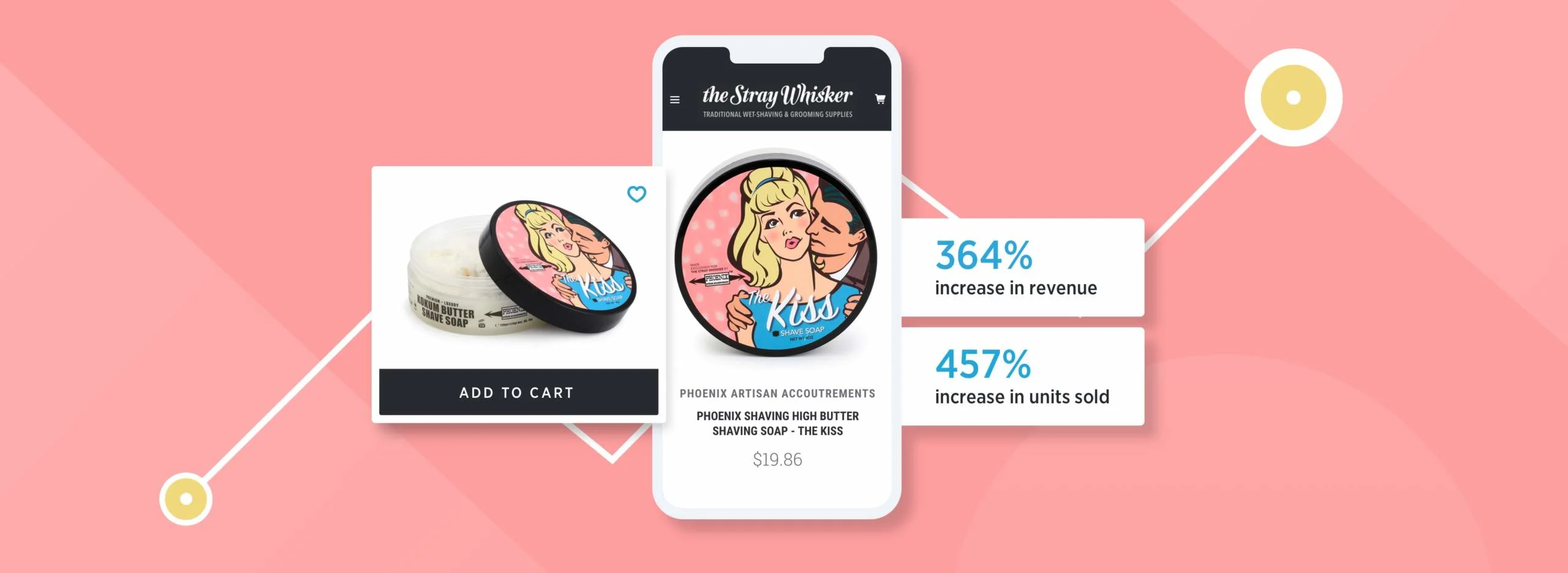
Did you know that customers who stick with your brand over time will spend 67% more than new customers?
While this might be hard to believe, your existing customers are the ones who hold the key to your business’ long-term success.
However, if this is the case why are so many brands still focused on customer acquisition?
Surveys have shown that more marketers’ top priorities are still brand awareness and customer acquisition, even with everything we know about the power of customer retention.
So I want you to ask yourself: do I have the right priorities? If you don’t, you’re in the right place.
Customer retention is the key to a sustainable business, and we’ve got a slew of facts, figures, and examples to prove it to you.
What is Customer Retention?
If you Google the term “customer retention,” you’re bound to find a lot of long definitions that use a lot of jargony business terms to describe it.
Simply put, customer retention is maximizing the value of your existing customers.
With a retention marketing strategy, your ultimate goal is to keep more customers shopping at your store for a longer period of time.
This not only makes each customer more profitable, but also focuses your attention on making sure every customer stays engaged, happy, and coming back.
Why Customer Retention Matters
For a long time, retention marketing was considered a new way of thinking.
The idea of shifting your focus from acquisition to retention was considered bold, and very few brands were actively working to move the needle in that direction.
Considering a 5% increase in customer retention can lead to a 95% increase in revenue, this was extremely surprising.
However, customer retention has quickly become the norm as heavy competition continues to increase in every industry.
This is especially true online, where platforms like BigCommerce continue to make it easier and more accessible for anyone to start their own store.
This ecommerce climate makes it impossible for anyone to compete on price.
With Amazon monopolizing the low-cost market, it becomes a race to the bottom to see who can offer the biggest discounts.
This conditions customers to expect ridiculously low prices and encourages them to take their business elsewhere when you can no longer offer a better deal.
Unfortunately, this isn’t the only downside to increased competition.
As brands continue to undercut you on price, the cost of paid ads continues to grow as more and more brands are competing for ad space.
This vicious cycle creates an “illusion of growth” that has you funneling money into channels that are ultimately unsustainable.
At the end of the day, it now costs more to acquire a new customer than to retain an existing one, making it the obvious choice for investing in the future of your business.
How To Measure Customer Retention
So how do you know if you’re actually increasing customer retention?
Being able to track and measure retention metrics allows you to set yourself up for success.
Thankfully, there are a number of incredible metrics that will give you insight into how well you’re incorporating customer retention into your business strategy.
Whichever metrics you choose to use, the key is to measure them regularly.
Checking them once and never looking at them again is one of the biggest mistakes businesses new to the idea of retention marketing make because it only shows you one small part of the picture.
As the ongoing solution to your brand’s sustainable growth, you need to perform regular checks to make sure you’re moving in the right direction.
The following 5 metrics are the best place to start your customer retention mangement by setting your brand’s benchmarks and make measuring each of them a regular part of your marketing plan.
1. Customer churn rate (CCR).
Your customer churn rate shows you how many customers you’ve lost over a specific period of time.
These customers have stopped making purchases, and as a result have indicated that they no longer find value in your brand.
As a result, you want to keep this number as low as possible.
You’ll know your retention strategy is working if it continues to decrease over time.
How to calculate:

Since this is a leading indicator of how well you’re customer retention program is doing, you should measure this metric on a month-to-month basis.
You do that by dividing the number of customers you lost in a month by how many customers you started that month with, giving you the percentage of customers who chose not to come back.
2. Repeat purchase rate (RPR).
This metric shows you what percentage of your customers have made more than one purchase at your store.
These shoppers are the most important ones you have because even though they only make up 8% of your customer base, they’re responsible for a 40% of your annual revenue!
How to calculate:

You only need two pieces of information to calculate your repeat purchase rate: the number of customers who’ve bought from you more than once and your total number of customers.
When you divide the number of customers who bought from you multiple times in the past year by the total number of customers you have, you get an idea of how your customer experience impacts purchase behaviors.
With this information, you can begin to improve it with a strong retention strategy.
3. Purchase frequency (PF).
Although this metric might sound similar to your store’s repeat purchase rate, it actually gives you more of a bird’s eye view of how often customers engage with your store.
While repeat purchase rate only looks at repeat purchases specifically, your purchase frequency looks at how often an average customer makes any kind of purchase at your store.
As your PF goes up, so will your revenue, which means it’s not so much a specific number as the increase that matters.
How to calculate:

In order to accurately calculate your store’s purchase frequency, you need to know how many unique customers you had in a given time frame.
Once you have that number, all you need to do is divide the number of orders by your number of unique customers.
Calculating this metric using data from the past year will make sure you have a big enough sample size to track changes in purchase behavior.
4. Average order value (AOV).
Average order value tells you how much the average customer is spending on each purchase.
This makes it easy to see how much each customer is worth and to gauge whether you’ve actually built strong, emotional connections with your existing customer base.
When your average order value goes up, the less you need to spend trying to acquire new customers.
This means less money sunk into ads and more in your pocket.
How to calculate:

To calculate your AOV, simply divide the total amount of revenue you’ve made in the past year by the number of orders made at your store.
5. Customer lifetime value (CLV).
This is the creme de la creme of retention metrics.
As we know, customers who love your brand are more likely to spend more with you over time.
That means that your CLV gives you the best idea of how valuable each customer will be to your store over time and in turn how valuable they find your brand.
When you can see the value of each customer relationship, it’s easier to wean yourself off a heavy acquisition strategy and focus on the areas of your experience specifically designed to retain each hard-won valuable customer.
How to calculate:

For many people, calculating CLV can be a bit intimidating because it requires a couple pieces of information.
However, it doesn’t have to be complicated!
Once you know your average customer value and your store’s average lifespan, you simply need to multiply them together to get a better idea of whether your customers are spending more and making purchase more often.
If this value increases over time, you know you’re well on your way to a super successful customer retention strategy!
Defining Your Customer Retention Strategy
Now that you know how to effectively measure customer retention, it’s time to start actively improving each of those metrics!
The best way to do that is with a clearly defined retention strategy.
This strategy will act as a your brand’s blueprint for how you’re going to achieve the larger goal of retaining customers.
Let’s look at the two most effective customer retention strategies you need to start at your store.
1. Value-add marketing.
Your customers don’t want to be sold to, which is why more of them are using ad blockers every single day.
With unwanted sales pitches coming at them from every angle, you need to do something else to cut through the noise.
Value-add marketing is the perfect solution because it allows you to exceed your customers’ expectations every time they interact with you.
It’s an empathetic approach to marketing that seeks to delight your customers and sets you up as a brand that’s more concerned with the experience they have with you than simply making money.
The best way to start value-add marketing is to become an expert in your field.
Creating how-to videos, running webinars and workshops, and regularly posting to a blog are all great ways to establish yourself as a leader in your industry.
The key with any of these approaches is to consistently create content your customers can engage with.
Spellbinders YouTube video
Spellbinders is a great example of a brand who understands the benefits of value-add marketing.
Through social, video, and blog content, they’ve built emotional relationships with their customers by becoming the go-to authority on crafting techniques, tips, and trends.
By delivering more than what they came for, Spellbinders makes it easy for shoppers to trust them and makes it possible for every customer to have a fantastic experience every time they shop.
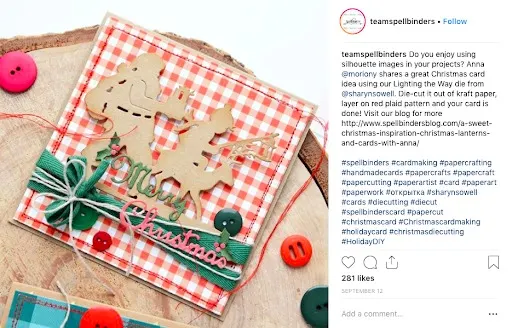
Paying attention to ways you can add more value to your customer experience will set you up as a brand that has your customers’ best interests in mind — the type of brand customers will want to keep doing business with.
2. Building a brand community.
While this phrase might be relatively new to you, the idea it stands for most definitely is not.
A brand community is a group of customers who all have emotional relationships with your brand, and are willing to engage with you beyond an initial purchase.
These strong feelings of loyalty change the ways they interact with you, making each engagement more than just another transaction.
You can build your own brand community with tools like value-add marketing in just 3 steps:

Encourage customers to join by creating an account
Motivate members to engage with your brand by making purchases, leaving reviews, engaging on social, etc.
Incentivize members to share your brand with others with referrals and social media
Each of these stages work together to create deep emotional connections that tether customers to your brand, increase customer satisfaction, and improve customer loyalty.
These relationships then create a powerful switching barrier that makes it difficult for customers to imagine shopping anywhere else.
The Most Effective Customer Retention Tactics
With a clear retention strategy, you’re now ready to choose which retention tactics and tools you’d like to use.
These are the things that will help you actually carry out the strategy you outlined earlier and will be useful for measuring your strategy’s success.
While there are countless ways you could improve retention at your store, we’ve gathered the very best ones here for you in one place.
All you need to do is pick your favorites and put them into practice.
1. Running a rewards program.
Rewards are by far the best vehicle for build a brand community.
With points, VIP tiers, and referrals, you can easily connect each of the 3 stages to make every point of interaction more valuable for your customers.
With the promise of increased incentives and incredible rewards, your customers will be more motivated to engage with you through purchases, user-generated content, and social media.
Most importantly, a rewards program strengthens the switching barrier your brand community introduces.
Now, they would have to forfeit points and future rewards if they choose to switch to a competitor, making it an easy decision to stay where they are.
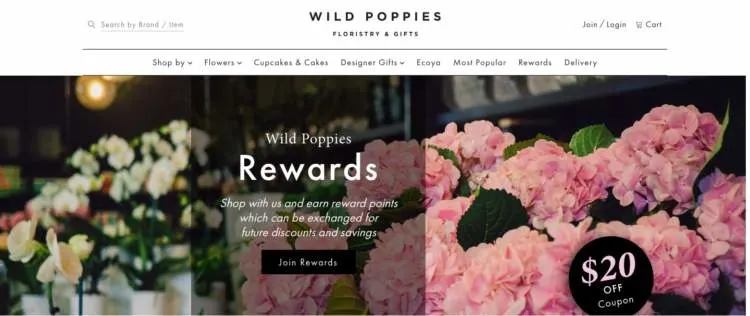
This strategy has worked well for Wild Poppies, a flower delivery service based in New Zealand.
With their Wild Poppies Rewards program, they give their customers the opportunity to earn dollars off coupons by completing a number of actions, including liking them on social media, creating an account, and placing an order.
They even reward customers for celebrating a birthday, making each emotional connection to their customers stronger with a personalized reward experience.
Acting as the central hub of their brand community, Wild Poppies’ rewards program has given them the tools they need to get more customers to join and stay engaged with their brand.
2. Referral marketing.
As much as you want to encourage existing customers to make repeat purchases, you always want to motivate your existing customers to refer you to their friends.
83% of customers admit that they are always more likely to trust recommendations from their peers than your brand, making peer-to-peer referrals the most effective way to share your brand community with others.
By letting your existing loyal customers do the heavy lifting for you, referrals become the best way to reduce your acquisition costs and ensure your customers are still engaged, especially if you reward them for it.
Incorporating referrals into your rewards program is an excellent way to ensure customers are not only returning to your store but also increasing brand awareness at the same time.
However, it’s important to remember that like refers like. In other words, discount seekers will refer other discount seekers to your store, making an established brand community key to a referral program’s success.
With an established brand community, referrals become the best way for valuable customers to refer new, equally valuable customers to your store.
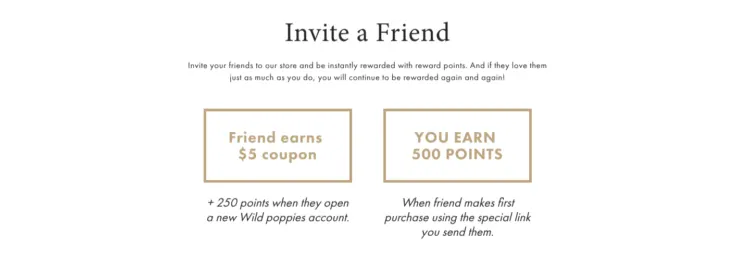
You can see that at work in Wild Poppies’ program.
As a Wild Poppies Rewards member, you have the opportunity to earn 500 bonus points for every successful referral you make.
In return, the friends you refer earn $5 off their first purchase, making it valuable for both sides.
Offering reciprocal value this way reduces the transactional nature of your brand community and increases the emotional attachment to every action customers complete at your store.
Now, they’re part of a larger, more valuable process that benefits not only themselves but their best friends as well, which is a feeling they will want to stay a part of.
3. Personalization.
One of the best ways to build a meaningful relationship with every customer is personalization.
Using your customer data to deliver more relevant experiences to every customer will make them feel special and important, reminding them of why they chose to shop with you in the first place and encouraging them to come back in the future.

Since you already have all of the information you need, personalization is one of the easiest customer retention strategies you can use.
Simply addressing emails using a customer’s first name or recommending products based on their shopping history goes a long way towards increasing satisfaction and loyalty.
In fact, these types of experiences are enough to convince 44% of customers to make another purchase!
These small but significant personalizations demonstrate your commitment to each individual customer — a commitment they’ll want to reciprocate by making one more purchase.
4. Gamification.
Social status is extremely valuable.
When customers feel like they’re part of an elite group, they will do anything they can to retain that status and will even go out of their way to tell others about it!
This desire to be the best is a result of gamification, and is largely responsible for making VIP programs so powerful.
Familiar concepts like leaderboards, status bars, and badges are all extremely motivating for keeping a customer engaged long-term, and can all be easily tied into an existing rewards experience.
When you connect status to perks and rewards, you immediately make each store action more exciting and increase the likelihood of customers investing in the engage and share stages of your brand community.

Take Golf4Her, for example.
In an effort to recognize and reward their best customers, they built a four-tiered VIP program designed to keep customers engaged at every stage in their customer journey.
With brilliant puns and an easy-to-understand tier breakdown, customers can quickly see that the perks improve as they move up through each level of their loyalty program.
With rewards like free gifts, special discounts, and first dibs on new products up for grabs, Golf4Her’s Loyalty Program makes the most of gamification to ensure every customer sees the value of shopping with them more than once.
5. Seeking customer feedback.
Customer feedback is a great way to determine how customers feel about your brand at any given time.
Giving them the change to share their experience with you can give you valuable insight into how you can improve that experience for them in the future.
This follow-through is a fantastic way to make your customers feel valued and important.
Just like personalization, it demonstrates a commitment to their personal experience and gives them a reason to choose your brand over another simply to experience those positive feelings again.
The trick is always getting customers to actually share with you.
Thankfully, there are lots of ways you can ask for it:
Include a survey in post-purchase emails or weekly newsletters
Run a giveaway that’s only open to those who give feedback
Add a call-to-action to your account or product pages
Offer reward points for giving feedback to multiply the value of sharing with you
No matter how you choose to do it, keep your calls for feedback short and sweet.
The easier it is to share their feedback the more likely they are to do it, giving you the information you need to keep delivering an experience they want to be a part of.
6. Livechat and customer support.
Conversational commerce has been picking up steam recently, and that’s because customers want to be able to get in touch with you!
More importantly, they want to be able to talk to you in the method of their choice.
48% of customers believe this is the most important factor of a personalized customer experience, which means you need to give them multiple ways to interact with your support team.
Live chat is by far one of the best avenues for encouraging conversations with your customer sand improving customer service.
By operating in real time, it creates space to build real connections with each customer who gets in touch with you.
Whether you’re helping them find the right product or solve problems, you can use live chat to become more relatable, accessible, and human.
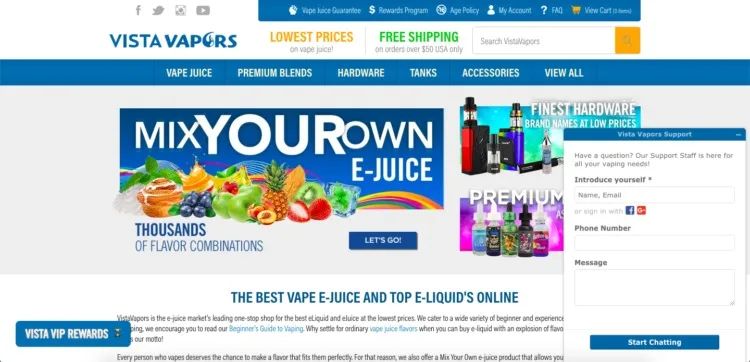
Vista Vapors puts this into practice with an easy to find live chat icon in the bottom right-hand corner of their store.
No matter where customers are on their site, they can easily get the help they need.
This live chat feature, combined with their other social channels and frequently asked questions page, allows customers to get the support they need in the method they prefer.
Offering this type of multi-pronged support vastly improves you customer retention because it lets customers know you care about their experience and want them to find what they’re looking for.
This will position you in front of your competitors who don’t make support as accessible.
7. Create “magic moments” for customers.
Did you know that 9/10 customers will shop with a competitor following a bad customer experience and that 81% of customers are willing to spend more for a better experience?
With that in mind, providing an exceptional brand experience is by far one of the best ways to increase referrals, improve overall satisfaction, and ensure customers will want to shop with you again.
A great way to deliver a great experience is by creating “magic moments” for your customers.
Much like value-add marketing, magic moments are something you deliberately create for your customers as a way of exceeding their expectations and putting their needs before your own.
Brands like Disney and Zappos have made these a backbone of their business, and as a result have been able to separate themselves as clear leaders with extremely loyal customers.
You can create magic moments for your customers in any number of ways.
Maybe it means including handwritten thank you notes or free samples with every order.
Perhaps it means offering free returns and designing a beautiful online experience that reflects your brand.
Whatever you choose to do, finding opportunities to create magic for your customers will strengthen their emotional connection with your brand and make them more likely to return in the future.
Better yet, it will prompt them to share their positive experience with others, once again decreasing your dependency on ads through the power of referral marketing.
8. Follow up after purchase.
Too often brands seem to believe that their customer experience ends after a purchase is made, but this is a misconception.
You have the power to impact your customer’s experience post-purchase as well with the most trusted form of communication: email.
77% of customers prefer to interact with brands through email over other channels, making it the best (and affordable!) tool to implement as a way of improving your customer retention strategy.
Following up with your customers post-purchase gives you the chance to validate their decision to shop with you and continue exceeding their expectations and improve brand loyalty.
Why not recommend a few new products they might like or ask them to share their thoughts in a review?
You can make these interactions even more valuable by integrating them into a rewards program.
With points balance reminders and invitations to earn more rewards, your program becomes the perfect hub for sending additional value post-purchase — value that improves engagement, increases their desire to return, and keeps your brand top of mind all at once.
Putting it Into Practice
Whether ecommerce customer retention was a new concept for you or not, you now have all the tools you need to start building your own increase retention strategy, and the best part is it only takes three steps to get started:
Calculate your metrics.
Choose your retention strategies.
Measure, iterate, and repeat!
With these benchmarks, strategies, and tips under your belt, you are well on your way to getting more repeat customers, improving your profitability, and setting yourself up for sustainable growth through these retention efforts.

Kirsten is a Marketing Specialist and lead editor of the Smile blog. With experience helping merchants in virtually every industry build strong brand communities, she is committed to transforming the world of commerce into one based on true emotional relationships and making magic where she can.


